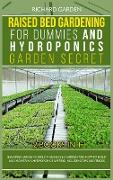- Start
- Raised Bed Gardening for Dummies and Hydroponics Garden Secret
Raised Bed Gardening for Dummies and Hydroponics Garden Secret
Angebote / Angebote:
This bundle includes 2 books in 1Do you have problems growing your vegetables?Have you heard about raised gardening and hydroponics, and are you interested in discovering more about them?So, interested in Gardening through Hydroponics Method and build a Raised Bed Garden? If yes, this is the right book for you.Growing vegetables in raised beds make gardening a pleasureWith limited time and space, you can grow an abundance of food in a small area.Benefits:It allows you to grow an abundance of food in a small area.Customize the terrain precisely to your needsFewer weeds and pestsBetter drainageBetter terrainIt does not require effort as soil compaction is already considerably reduced.Less potential pain for you, gardener... to name but a few.Your friends will envy your tidy and attractive garden and your healthy and tasty vegetable crop. :)Raised horticulture allows us to plant very early at any time since, unlike conventional gardening techniques, raised flower beds can heat up faster after the winter months, and thanks to the quick drainpipe features, raised flower beds to allow even early sowing after a wet period. Also, relief horticulture is much more systematic than normal, which allows us to optimize the planting area.Finally, the advantage we get from raised gardening is that, when properly designed and implemented, it is even more pleasing to the eye as it mimics the landscape of your home, not like a typical garden.Hydroponics is a way to grow plants in an aqueous solution rich in nutrients. The roots are supported using a medium such as vermiculite, peat moss, clay balls, Rockwool, or perlite. The rationale behind hydroponics is to let the roots come into contact with the solutionBenefits:Plants have access to a lot of oxygen they need.The root system of plants will experience less stress than when grown traditionally, as they do not have to find food from the soil and can convert nutrients into energy much faster. This will result in more significant production in a short amount of time.Since the plants are grown without soil, it is necessary to maximize the nutrient uptake of the roots. This means that how you give the roots their nutrients is extremely important.Hydroponics has had a place in various civilizations throughout history. The floating gardens in China and Mexico, along with the hanging gardens in Babylon, are some examples of hydroponic culture. However, great strides have been made in this area of ¿¿agriculture over the years.Over the past century, horticulturists and scientists have experimented with various hydroponic methods. Hydroponics was used during World War II to provide troops stationed on various islands in the Pacific where food would not easily grow with products they were able to grow themselves.This book covers: Building StructuresSoilPlantingGrowing And HarvestingMeasures and Number of PlantsWhat is Hydroponic Gardening?Hydroponics Gardening Vs. AquaponicsHydroponics Vegetable GardeningHydroponics Grow SystemWhich Plants Can Be Grown with Hydroponics...And Much More! Grab your copy today and let's get building gardens!!!
Fremdlagertitel. Lieferzeit unbestimmt
